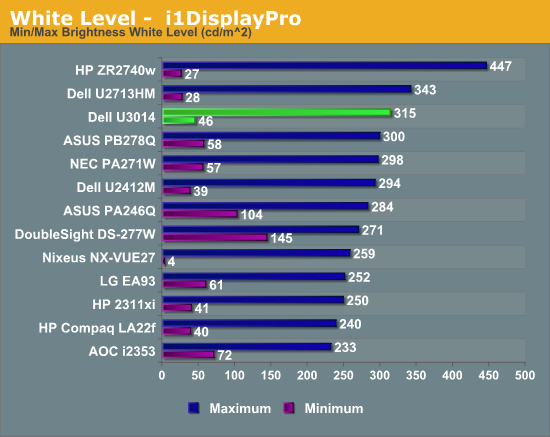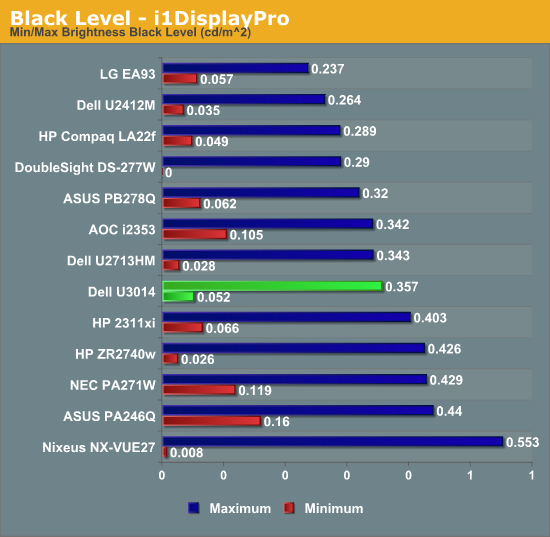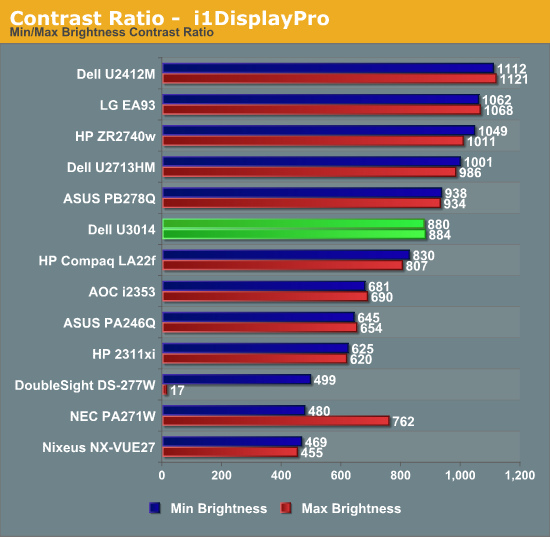Dell U3014 LCD Review
by Chris Heinonen on April 15, 2013 2:00 PM ESTThe Dell U3014 is rated for 350 cd/m2 on the spec sheet, but I found the most I could get it to produce was 315 cd/m2. It would likely produce more if you were to push the contrast all the way to the maximum, but doing so clips the top whites, so all your highlights suddenly become a single shade instead of distinct. It might make the numbers look worse, but not allowing clipping makes for an honest number, and 315 cd/m2 is what the U3014 can do. With the backlight at the minimum, it drops down to only 45 cd/m2 of light, which is good. That gives you lots of room to work with, and most users will be fine with these levels.

Black levels with the backlight at maximum are 0.357 cd/m2, and that drops down to 0.052 cd/m2 at minimum backlight. Dell offers a dynamic backlight on their displays where a pure black screen totally disables the backlights, giving you “infinite” contrast, but that option is disabled in the most color-accurate modes. It also seems be an all-or-nothing approach, and not one where you can selectively enable and disable part of the edge lighting. I’m not a fan of dynamic backlighting unless you have a full backlit LED array, where you can enable and disable it for parts of the screen at once, and find they are usually just tricks to make their contrast numbers seem better than they are. Dell is honest and gives you real and dynamic numbers in their specs, though.

These numbers wind up giving us a contrast ratio in the area of around 900:1. This is maintained from 0-100 percent on the backlight intensity, so it’s an honest 900:1 contrast ratio from the Dell U3014. There are some recent displays that have hit closer to 1,100:1 but these numbers are still quite good overall, and maintaining it across the whole range of brightness is ideal.

This is a decent start for the U3014, but the real question for me is if they can keep the colors accurate in all color spaces with that new G-B LED backlight system.










84 Comments
View All Comments
Kevin G - Monday, April 15, 2013 - link
That Sharp display I've seen at sites going for $4500. Still expensive but a definitive step up in terms of resolution from this Dell. I'd love to see a review of it here at Anandtech. *hint* *hint* *hint*jibberegg - Monday, April 15, 2013 - link
Apparently Seiki are offering 50" 4k for $1,500. Anyone heard of them? I smell bad things at that price, but don't want to write it off without more information.http://www.tigerdirect.com/applications/SearchTool...
SeannyB - Monday, April 15, 2013 - link
The current HDMI spec only does up to 30Hz in 4K. This is the thing that stops me from buying one right now, because using Windows or whatever at 30 frames per second is miserable.Kevin G - Tuesday, April 16, 2013 - link
Digging through the Seiki manual indicates that 30 hz is the best frame rate it can get at 4k resolutions. Might be fine for video as the source material in all likelihood doesn't exceed this rate.Another passable usage would to use it as a large format display for 2D imagery. This would be the equivalent of four 1080P 25" monitors of screen space, minus the bezels. Color quality and calibration controls are an unknown, so this use-case is iffy.
For gaming, this refresh rate is going to be horrible.
cheinonen - Thursday, April 18, 2013 - link
FYI, it has no calibration controls at all: no white balance, no CMS, no gamma, nothing. So if you want an accurate image, double the price to include a DVDO or Lumagen box, and those don't work with 4K material yet.SantaAna12 - Monday, April 15, 2013 - link
Apples to apples???High end monitor review....no comparison to Apple.
Hmmmmmmm.......your welcome Dell!
cheinonen - Monday, April 15, 2013 - link
I didn't review the Apple, Anand did himself, and it was with our prior test bench. It's also a white LED backlit model with the sRGB gamut, not a CCFL or G-B LED backlight with AdobeRGB gamut, or any sort of uniformity control. It's a high-end, general use 27" display, not a professional photographer/graphics display, which this is. There isn't a lack of a comparison to spare one of them, they're different markets, with different test bench data.p05esto - Monday, April 15, 2013 - link
You are out of your mind if you think an Apple monitor could touch this. lol, just another clueless Apple sheep.Kevin G - Monday, April 15, 2013 - link
Have you tested the MST functionality of this device? I'd to see how this works out, especially with this and a DP 1.1 monitor.cheinonen - Monday, April 15, 2013 - link
I did, and it's discussed in the article. Worked fine with the monitor I have here, with a couple of caveats.